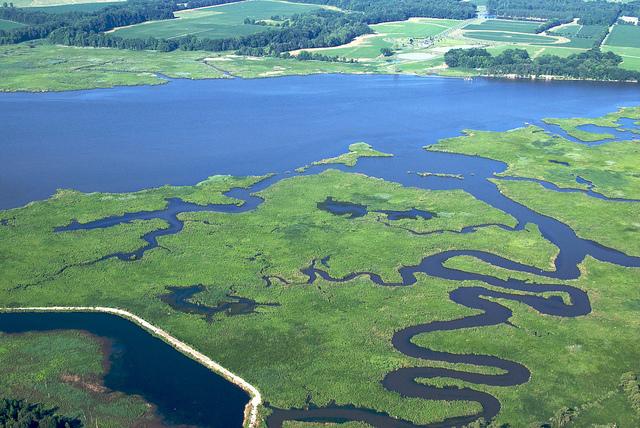Senators from the Chesapeake Bay region are asking the Biden administration to enforce strict water pollution standards in Pennsylvania and New York to help meet previously-agreed goals for restoring the Bay.
The lawmakers, all Democrats, told new Environmental Protection Agency Administrator Michael Regan in a letter last month that efforts to reduce certain Bay pollution sources by 2025 “are at a critical juncture.”
“Our concern has been the state of Pennsylvania has been falling significantly short of the goals that they need to reach in order for us to meet the overall pollution goals for the Bay in 2025,” Sen. Chris Van Hollen, D-Maryland, one of the co-authors of the letter, said in an interview with Capital News Service.
The senators told Regan that Pennsylvania would only meet 75 percent of its target to cut nitrogen pollution. New York also would fall short of its nitrogen goal by 1 million pounds, they said.
In addition to Van Hollen, the senators on the letter were Ben Cardin of Maryland, Tom Carper and Chris Coons of Delaware, and Mark Warner and Tim Kaine of Virginia.
In 2010, the EPA established the Chesapeake Bay Total Maximum Daily Load for pollutants permitted without violating water quality standards. The standards applied to the Bay’s surrounding states: Maryland, Virginia, Pennsylvania, West Virginia, Delaware, New York, and the District of Columbia.
“It sets limits for pollution that equate to a 25 percent reduction in nitrogen, 24 percent reduction in phosphorus, and 20 percent reduction in sediment,” the senators’ letter noted.
Under the Bay pollution daily load plan, the EPA has the power to enforce water quality standards and to require additional reductions in sources of pollution to meet the 2025 goals.
“We ask that you use all tools at your disposal…to make sure that all jurisdictions are on track for 2025,” the senators wrote.
“Because the Bay is a watershed that encompasses multiple states and the District of Columbia, the role of the federal government through the EPA is essential to bringing different states together to comply with our pollution reduction targets,” Van Hollen told CNS.
Last September, the Chesapeake Bay Foundation filed a lawsuit against the EPA for “failing to comply with their responsibilities under the Clean Water Act and the Blueprint,” according to the foundation’s website. The case was later consolidated with similar lawsuits filed by attorneys general in Maryland, Virginia, Delaware and the District of Columbia.
“Those (lawsuits) in my view are important measures to take to push the EPA in the right direction,” Van Hollen said. “The previous administration did not do enough, in my view.”
Foundation President William Baker said in January that “if Pennsylvania does not meet its obligations… the Chesapeake Bay will never be saved.”
The EPA responded to a request for comment from CNS with this statement: “Administrator Regan, in remarks as a nominee before the Senate Environment and Public Works Committee, acknowledged that the Chesapeake Bay is a national treasure. He offered his commitment as EPA administrator to ‘look for all the resources we can bring to bear to protect the Chesapeake Bay’ and to help our state partners meet the 2025 goal of having all practices in place to restore the Bay and its tidal waters.”
“As such,” the statement continued, “we look forward to taking the next steps in providing funding and technical assistance, tracking and reporting progress, coordinating and facilitating partnership efforts through the Chesapeake Bay Program Office, and taking appropriate actions within our Clean Water Act authorities.”
Van Hollen added that he is hopeful the Biden administration and the EPA will provide states the tools or resources they need to meet the pollution standards and use its enforcing power for states like Pennsylvania.
“This was a letter to accomplish two goals,” Van Hollen said, “One is to say ‘We look forward to working with the Biden administration to protect the Chesapeake Bay,’ but also, ‘We’re counting on you to strongly enforce the pollution reduction goals that are necessary to keep the Bay healthy.’”
Meanwhile, the governors of the states in the Bay watershed, along with District Mayor Muriel Bowser and Virginia Del. David Bulova, chairman of the Chesapeake Bay Commission, are asking Congress for more federal support for cleanup.
“Our proposal is the Billion for the Bay Initiative: a significant and much needed infusion of new funds that will jumpstart the final phase of Bay restoration and put people to work building clean water infrastructure, including green infrastructure that will reduce stormwater and agricultural water pollution, the restoration of natural landscapes, and helping us adapt to the impacts of climate change,” the May 13 letter to congressional leaders said.
The governors signing the letter were Maryland’s Larry Hogan, a Republican; Virginia’s Ralph Northam, a Democrat; Pennsylvania’s Tom Wolf, a Democrat; West Virginia’s Jim Justice, a Republican; Delaware’s John Carney; and New York’s Andrew Cuomo, a Democrat.
The Chesapeake Bay Total Maximum Daily Load is intended to address decades of pollution in the 64,000-square mile watershed from urban and agricultural runoff, wastewater contamination and air pollution. The poor water quality not only has affected aquatic life but also has threatened industries dependent on the Bay, from recreational tourism to fishing.
The Bay and its many tributaries is home to nearly 18 million people and hosts a vast array of 3,700 species of fish, animals and plants.

